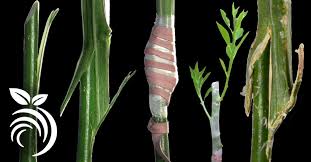Grafting is a horticultural technique that joins parts from two plants, enabling them to grow as a single, unified plant. This method is widely used in fruit tree propagation to combine the desirable traits of both the rootstock and the scion. By following this step-by-step guide, you’ll learn how to graft trees correctly and efficiently, including the specialized technique of grafting under the bark.
1. Choosing the Right Time for Grafting
The ideal time to graft trees is during late winter or early spring, just before the sap begins to flow and the buds start to break. Grafting during this period allows the graft to heal and establish growth as the growing season progresses.
2. Selecting the Scion and Rootstock
Scion: The scion is the upper part of the grafted plant. It’s essential to select scion wood from a healthy, disease-free tree that’s about one year old. Ensure the scion has 2-3 visible buds, as these will sprout into new growth.
Rootstock: The rootstock serves as the lower part of the graft, providing the root system and support. It should be compatible with the scion species, healthy, and well-established. The diameter of the rootstock may vary depending on the grafting method you’re using.
3. Common Grafting Techniques
There are several effective methods for grafting trees, each suited for different purposes and plant sizes.
Whip Grafting:
- Best used when the scion and rootstock are of similar size.
- Create diagonal cuts on both the scion and rootstock, then join them so their cambium layers (the green layer beneath the bark) align.
Cleft Grafting:
- Suitable for larger rootstocks.
- Make a vertical cut (cleft) in the rootstock and insert a scion with a wedge-shaped end into the slit.
Bud Grafting (Budding):
- Commonly done in summer when buds are mature.
- Insert a single bud into a small incision on the rootstock’s bark.

4. Grafting Under the Bark
This method is particularly effective for large rootstocks and when the bark peels away from the wood easily, typically in spring.
Steps to Graft Under the Bark:
- Make a T-shaped or vertical cut in the bark of the rootstock.
- Carefully peel back the bark’s flaps to expose the cambium layer.
- Insert the scion, ensuring it has a few buds and a small section of wood attached.
- Position the scion so it’s in direct contact with the cambium layer of the rootstock.
- Secure the graft with grafting tape or wax to hold it in place and prevent moisture loss.
5. Aftercare of Grafts
Proper aftercare is essential to ensure a successful graft.
- Seal the graft with grafting wax or tape to prevent it from drying out and to protect it from pests and diseases.
- Water regularly but avoid overwatering, as excessive moisture can cause rot.
- Avoid fertilizing until the graft has healed and shows signs of growth.
- Monitor progress, checking for new growth or signs of graft failure, such as wilting or discoloration.
6. Tips for Grafting Success
To increase the likelihood of a successful graft, follow these essential tips:
- Sanitize tools to prevent the spread of diseases between plants.
- Make clean, precise cuts to create better contact between the scion and rootstock’s cambium layers.
- Label your grafts to track tree varieties and grafting dates for future reference.
- Practice patience, as some grafts may take time to fully establish and grow.
Grafting is a rewarding technique that allows gardeners and orchardists to create unique fruit tree combinations or restore damaged trees. By mastering the different grafting methods—especially under-the-bark grafting—you’ll be able to propagate trees more effectively and enjoy the fruits of your labor for years to come. With proper timing, technique, and care, your grafting efforts are bound to yield productive results.
